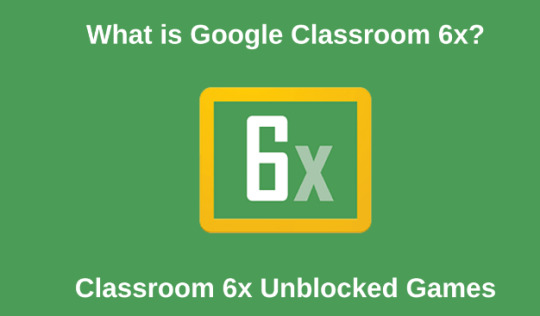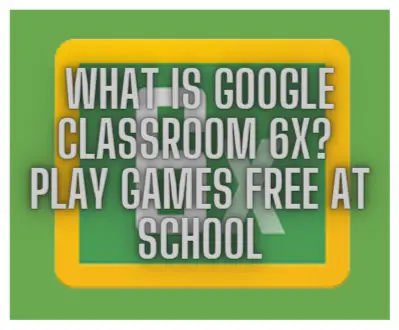#GoogleClassroom
Explore tagged Tumblr posts
Text
#GoogleClassroom#GeminiAI#EdTech#AIinEducation#TeacherTools#QuizMaker#FutureOfLearning#AIpoweredEducation
0 notes
Text
구글 클래스룸 관리, 더 깔끔하게! 🎓
구글 클래스룸에서 수업이 너무 많이 쌓여 혼란스럽다면, 지금이 바로 정리할 때! 수업을 삭제하는 방법, 보관 처리로 깔끔하게 숨기는 방법, 그리고 효율적인 관리 꿀팁까지 모두 담았습니다.
복잡한 목록은 가볍게, 학습 환경은 더 효율적으로! 중요한 자료는 안전하게 백업하고, 필요 없는 수업은 삭제하거나 보관하여 더 깔끔한 화면을 만들어보세요. 🌟
디지털 정리는 작은 습관에서 시작됩니다. 지금 바로 따라해 보세요! 더 나은 학습 환경이 기다리고 있습니다. ⬇️
0 notes
Text
Google Classroom 6X : Elevating the Learning Experience

In the ever-evolving landscape of education, finding effective methods to engage students is essential. With the introduction of Google Classroom 6X, teachers have access to a powerful platform that integrates various tools to facilitate learning. One of the most exciting features of this updated version is the incorporation of games into the classroom setting. This blog explores the significance of games in education, the types of games available on Google Classroom 6X, and strategies for effectively using them to enhance learning outcomes.
The Importance of Games in Education
Games are more than just a fun pastime; they offer numerous educational benefits:
1. Enhanced Engagement
Games capture students' attention and encourage active participation. When students are engaged, they are more likely to absorb information and develop a deeper understanding of the subject matter.
2. Motivation and Achievement
The competitive nature of games can motivate students to excel. Earning points, badges, or rewards fosters a sense of achievement, pushing students to strive for higher performance.
3. Skill Development
Educational games often focus on critical skills such as problem-solving, critical thinking, and collaboration. These skills are essential for academic success and future career opportunities.
4. Safe Learning Environment
Games create a low-stakes environment where students can experiment and learn from their mistakes without fear of failure. This encourages a growth mindset and resilience.
Exploring Google Classroom 6X
Google Classroom 6X is designed to streamline classroom management while promoting an interactive learning environment. Its user-friendly interface allows teachers to create, distribute, and grade assignments seamlessly. With the addition of games, educators can enhance the educational experience in numerous ways.
Types of Games Available in Google Classroom 6X
Google Classroom 6X offers a variety of games suitable for different subjects and learning objectives. Here are some popular categories:
1. Quiz-Based Games
Quiz games are an effective way to reinforce knowledge and assess understanding. Tools like Kahoot!, Quizizz, and Socrative can be integrated into Google Classroom. These platforms turn assessments into engaging competitions, making learning enjoyable.
2. Educational Puzzles
Puzzles encourage critical thinking and logical reasoning. Games such as Prodigy Math and Breakout EDU challenge students with math problems or strategic scenarios, enhancing their problem-solving skills and STEM education.
3. Simulation Games
Simulation games provide hands-on experiences in a controlled setting. Titles like SimCity and Minecraft: Education Edition allow students to explore concepts like urban planning and environmental science, promoting creativity and application of theoretical knowledge.
4. Collaborative Games
Team-based games promote collaboration and communication among students. Using platforms like Google Jamboard or collaborative Google Docs, teachers can create group activities that encourage teamwork and shared problem-solving.
5. Role-Playing Games (RPGs)
RPGs immerse students in historical events or complex scenarios, making subjects relatable. Games like “Zombies, Run!” or various history-based RPGs engage students by allowing them to explore different roles and outcomes based on their decisions.
Benefits of Integrating Games into Google Classroom 6X
1. Increased Student Engagement
Games significantly increase student engagement. When students play educational games, they become more involved and enthusiastic about the content, leading to better retention and a positive attitude toward learning.
2. Personalized Learning
Games often provide adaptive learning experiences, allowing students to progress at their own pace. Google Classroom 6X tracks performance, adapting game difficulty as needed, ensuring all students remain challenged.
3. Immediate Feedback
Games provide instant feedback, a crucial element of the learning process. Students can see their performance in real-time, helping them understand their strengths and areas for improvement, fostering continuous growth.
4. Healthy Competition
Leaderboards and point systems create a sense of friendly competition among students. This motivates students to engage deeply with the content while ensuring a supportive environment where everyone feels valued.
5. Development of 21st-Century Skills
Playing educational games helps students develop critical skills like collaboration, communication, and problem-solving, which are essential for success in the modern workforce.
How to Implement Games in Google Classroom 6X
1. Choose Appropriate Games
Select games that align with your learning objectives and subject matter. Ensure that the games reinforce the curriculum and can effectively engage students.
2. Create Assignments
Once you’ve chosen the games, create assignments in Google Classroom 6X. Provide clear instructions, objectives, and necessary resources. This ensures students understand the purpose of the games and how they relate to the curriculum.
3. Facilitate Gameplay
During gameplay, facilitate discussions and interactions among students. Encourage teamwork and communication. Use breakout rooms in Google Meet for virtual settings to allow small groups to strategize together.
4. Monitor Progress
Utilize Google Classroom 6X’s analytics tools to track student engagement and performance in the games. This data helps identify areas where students may need additional support and informs future teaching strategies.
5. Provide Feedback
After gameplay, offer constructive feedback to students. Discuss what they learned, what strategies worked, and areas for improvement. This reinforces the educational value of the games and encourages reflection.
Case Studies: Successful Game Integration
1. Gamifying History Lessons
Ms. Taylor, a high school history teacher, implemented Quizizz in her Google Classroom 6X for exam reviews. The gamified quizzes increased participation and led to higher retention rates, resulting in more enthusiastic engagement.
2. Collaborative Science Projects
Mr. Adams used Google Jamboard to facilitate collaborative science projects among middle school students. By creating interactive simulations, students worked together to explore scientific concepts, enhancing understanding and teamwork skills.
3. Math Mastery through Games
Ms. Green integrated Prodigy Math into her curriculum, assigning it as homework through Google Classroom 6X. The game-based environment helped students practice math skills effectively, leading to significant progress in competencies.
Tips for Successful Game Integration
1. Align with Learning Objectives
Ensure that chosen games directly support your learning goals. This alignment is crucial for maintaining educational relevance and effectiveness.
2. Encourage Collaboration
Foster a supportive environment where students work together and share strategies. Collaboration enhances the overall learning experience and builds interpersonal skills.
3. Monitor Engagement
Regularly assess student engagement with the games and adjust your approach as needed to maintain interest and enthusiasm.
4. Emphasize Reflection
Encourage students to reflect on their learning experiences after gameplay. This reflection reinforces the educational value of the games and promotes deeper understanding.
5. Stay Updated
Keep an eye on new educational games and trends. The landscape of educational technology is constantly evolving, offering new opportunities for engagement and learning.
Conclusion
Google Classroom 6X is revolutionizing the educational experience by integrating games into its platform. By leveraging the power of gamification, educators can create a more engaging, interactive, and effective learning environment. The benefits of incorporating games—enhanced engagement, personalized learning, immediate feedback, and skill development—make it a worthwhile endeavor for teachers and students alike.
0 notes
Photo

ग्राम भटगांव के निवासियों द्वारा प्राप्त जानकारी, village bhatgaon, bhatgaon, about bhatgaon, gram bhatgaon , महिलाओ द्वारा प्राप्त जानकारी
#Google#googleclassroom#googledocs#googledrive#googleflights#googlemaps#googlescholar#googletranslate#ब्लोगिंग#यूट्यूब
0 notes
Text
My Journey with Google Classroom: A Personal Reflection
Hey there, fellow educators and curious minds! Today, I'm excited to share a little glimpse into my experience with a tool that's become an integral part of my teaching journey: Google Classroom.
Let me start by saying, I'm a huge fan of Google Classroom. 🌟 From the moment I started using it, I discovered a world of possibilities at my fingertips. As a teacher, having the ability to control assignment due dates, share notes in various formats like docs, slides, and sheets, and even upload videos and links—all within one platform—has been an absolute game-changer for me.
But hey, let's get real for a moment. Like any tool, Google Classroom isn't without its challenges. One of the main hurdles I've encountered is attendance tracking. 🤔 It can be tough to keep tabs on who's present and who's not, especially in a virtual setting where students can easily slip through the cracks.
Another aspect that's left me wanting more is the assessment features. While Google Classroom offers basic assessment tools, I've found myself yearning for more advanced features when it comes to grading and providing feedback to my students. It's like having a toolbox with a few essential tools, but missing some of the more specialized ones that could really take things to the next level.
Despite these drawbacks, my love for Google Classroom remains unwavering. 💙 Sure, it has its limitations, but what tool doesn't? For me, it's all about finding creative workarounds and making the most of what's available. Whether it's finding alternative methods for attendance tracking or supplementing Google Classroom with additional tools for assessment, there's always a way to adapt and evolve as educators.
In the end, Google Classroom has been a true ally in my teaching journey—a reliable companion that's helped me navigate the ever-changing landscape of education. And while it may not be perfect, its benefits far outweigh its shortcomings. So here's to embracing the challenges, celebrating the victories, and continuing to learn and grow together.
Until next time, happy teaching and exploring, my friends! 🍎📚
1 note
·
View note
Text
Unlocking the Fun: Exploring Classroom 6x Unblocked Games

In today's digital age, educators are constantly seeking innovative ways to engage students in the learning process. One such method gaining popularity is the use of Classroom 6x unblocked games. These games offer a unique opportunity to blend entertainment with education, providing students with an immersive learning experience like never before.
Introduction to Classroom 6x Unblocked Games
Classroom 6x unblocked games refer to online games that can be accessed and played within the confines of school networks without restrictions. Unlike traditional video games, which may be blocked by school filters due to concerns about content or distractions, these games are carefully selected to align with educational objectives while offering an enjoyable gaming experience.
Understanding the Concept of Unblocked Games
Unblocked games are designed to bypass restrictions imposed by network administrators, allowing students to access them freely during designated times, such as breaks or after completing assignments. While the primary focus remains on education, these games incorporate elements of fun and interactivity to keep students motivated and engaged.
Benefits of Classroom 6x Unblocked Games
Enhancing Learning Experience
Unblocked games can serve as valuable teaching tools, supplementing traditional instruction methods with interactive experiences that cater to different learning styles. By presenting complex concepts in a gamified format, educators can make learning more accessible and enjoyable for students.
Promoting Problem-Solving Skills
Many unblocked games require players to think critically and strategize to overcome challenges, thereby fostering the development of problem-solving skills. By engaging in gameplay, students learn to analyze situations, formulate solutions, and adapt their strategies based on feedback – all essential skills for success in both academics and real-world scenarios.
Fostering Collaboration
Certain unblocked games offer multiplayer modes or cooperative gameplay, encouraging students to work together towards a common goal. Through collaboration, students learn the value of teamwork, communication, and shared responsibility, essential skills for navigating interpersonal relationships and collaborative projects.
Popular Genres of Unblocked Games
Educational Games
Educational games are specifically designed to teach or reinforce academic concepts in an engaging manner. These games cover a wide range of subjects, including math, science, language arts, and history, making them valuable resources for educators across various disciplines.
Puzzle Games
Puzzle games challenge players to solve problems or complete tasks by applying logic, spatial reasoning, and pattern recognition. These games can stimulate cognitive skills and promote critical thinking while providing a satisfying sense of accomplishment upon completing each level or puzzle.
Strategy Games
Strategy games require players to devise long-term plans and make strategic decisions to achieve victory. By simulating complex scenarios and encouraging forward thinking, these games help develop analytical skills, decision-making abilities, and foresight – qualities essential for success in academic and professional settings.
Arcade Games
Arcade games offer fast-paced, action-packed gameplay designed to entertain and challenge players. While primarily focused on fun, these games can also improve reflexes, hand-eye coordination, and reaction times, providing a well-rounded gaming experience that complements educational objectives.
Conclusion
In conclusion, Classroom 6x unblocked games represent a promising avenue for enhancing the educational experience and fostering student engagement. By leveraging the benefits of gamification, educators can create dynamic learning environments that cater to the diverse needs and preferences of modern learners. As technology continues to evolve, the integration of unblocked games into classroom settings is likely to become increasingly prevalent, offering new opportunities for innovation and creativity in education.
0 notes
Photo

Google Classroom: las mejores prácticas y trucos https://bit.ly/3P2Gxyh
0 notes
Text
2024年7月26日(金)

私の職場(私立女子大学)では、今日で前期授業15週が終了した。ここ数年は担当科目の関係で平日はすべて出勤、さすがに身体の疲れは隠しがたく、この暑さの中で<あと一日、あと一日>と自分を励まし続けてきたのだ。本来は<平日日本酒禁止令>が施行されているはずなのに、毎晩冷たくしたお酒を頂いてはダウン、夜中の2時もしくは3時に目覚めるという生活。だがそれも終わり、気持ちよくお酒を飲んで風呂に入って寝る生活を取り戻すぞー!(結局、呑むのだけどね)。

3時起床。
日誌書く。
あれやこれや。
5時15分シャワー、体重は100g減。

今日はツレアイ(訪問看護師)は休み、弁当はないので朝の用意がゆっくりできる。
珈琲を淹れ、洗濯物を干し、可燃ゴミ(30L*1)を出す。
一人で出勤。

茨木ICの出口が本線まで繋がっていたので、吹田ICで下りる。
換気、ラジオ体操第一、冷房を入れてお茶を頂く。
昨日の<スタディスキルズ(教育学科)>のレポートを���ェックする。

<ぴあ>で9/3(火)喜楽館昼席のチケットをゲット、この日だけ露の新治さんがトリなので。
金曜日は2限・3限<スタディスキルズ(栄養学科)>、火・木同様に授業アンケートと「振り返りレポート」を課す。普段は学内フォルダに提出させるのだが、今週は GoogleClassroom を利用する。ところが、クラスによっては扱い方を知らない学生もいるので、今日は全員Classroomの課題に GoogleDocumentを利用してレポートを書いて貰った。Wordで作成したものをアップするよりも遥かに簡単、両クラスとも早い時間に全員提出してくれた。
昼休みにラジオ体操第二。
O姉と一緒に退出。

今日も帰路の交通量が多かった。
O姉とは6年間ペアを組んで授業を担当していただいた。後期も2クラスの授業をお願いしているが、私と一緒の授業や通勤は今日が最後、大変お世話になりました。
ツレアイはあちこち買物や用足しで走り回っていたようだ。
夕飯の前にココに点滴。

今夜は刺身+ツレアイ作の玉子焼き、よく冷やした酒が美味しい。
録画番組視聴、刑事コロンボ。
第21話「意識の下の映像」/ Double Exposure 行動心理研究所の所長バート・ケプルは、ノリス産業の社長ヴィクター・ノリスを、CMモデルに誘惑させて二人の密会写真を撮り、ノリスを強請っていた。ある晩、研究所でノリスの会社のセールスマン意識向上の為のフィルム上映会が行われるが、ケプルは途中で水を飲みに出たノリスを殺害する。
片付け、入浴。やはり湯船につからなければ疲れはとれないね。

就寝前に、ぎりぎりで3つのリング完成。
4 notes
·
View notes
Note
fun fact when i was making my gimmick i almost chose to be googleclassroom instead of google news, but last minute inthought googlenews would be funnier
glad you went with news, I probably wouldn't have a gimmick if Google Classroom wasn't available.
maybe I would've done Chrome Music lab, but who knows!
3 notes
·
View notes
Photo

🎓 Scopri come sfruttare al massimo Google Classroom! 🚀 Ecco una guida completa su cosa è, i vantaggi e come massimizzare le sue potenzialità! 💡 Non perderti questo articolo: https://gianlucagentile.com/guida-completa-allutilizzo-di-google-classroom-cosa-e-vantaggi-e-come-sfruttare-al-meglio-le-sue-potenzialita/ 📚 #GoogleClassroom #ApprendimentoOnline #EducazioneDigitale #Vantaggi #CompitiOnline #RisorseDidattiche #Educazione #WebMarketing #EspertoSocial
0 notes
Text
Still can't log in to my googleclassroom🥲👍
This means I cannot access any work sent to me that I have to complete, this still hasn't been fixed meaning I can't do any work and am set wayy behind now. Verry stressfull do not recomend.


0 notes
Text
I made a Google classroom with all sorts of BOOKS (from mystery to dark romance) if anyone wants to join.
I'm planning to upload more soon + you can also request a book that you're looking for :)
The code is gsf73vc
#booksbooksbooks#book lover#book recomendation#book rec#book recommendations#books and reading#bookblr#booklr#googleclassroom#demtalk
9 notes
·
View notes
Photo

I have made a Supernatural Google Classroom where we can talk about the series, and ask eachother questions, and just talk about things, feel free to join!! And have fun! Thanks guys
#supernatural#googleclassroom#jensenackles#jaredpadlecki#mishacollins#spnedits#class#spngoogleclassroom
5 notes
·
View notes
Text
Virtual Drawing Event Page link: https://m.facebook.com/pg/Smallcomic/events/
We'll be takin turns drawing each others portraits for 5-10 minutes at a time. After each drawing we can share our work and discuss.
If you really don't want to go on cam and just draw instead that's fine also.
Meeting Link:
https://meet.google.com/ddx-ijrd-qvc
instagram
#googleclassroom#googlemeet#virtualclassroom#virtuallearning#dog#dogs#portraitdrawing#illustration#caricature#drawing#artteacher#freeclass#onlineclasses#sketching#mondaysucks#freeartlesson#cartoonist#drawingfromlife#meetup#facebookevent#how to draw#artforbeginners#beginner artist#artstudent#Instagram#monday motivation#monday funday
16 notes
·
View notes
Photo

Google Classroom: las mejores prácticas y trucos https://bit.ly/3P2Gxyh
0 notes
Text
Google Classroom
If anyone is interested I made a google classroom for witches there is already some material on there and I am in the middle of adding more.
Link: https://classroom.google.com/u/2/w/MTg2OTY5ODUzNDg2/t/all
Code: r3eqixh
3 notes
·
View notes